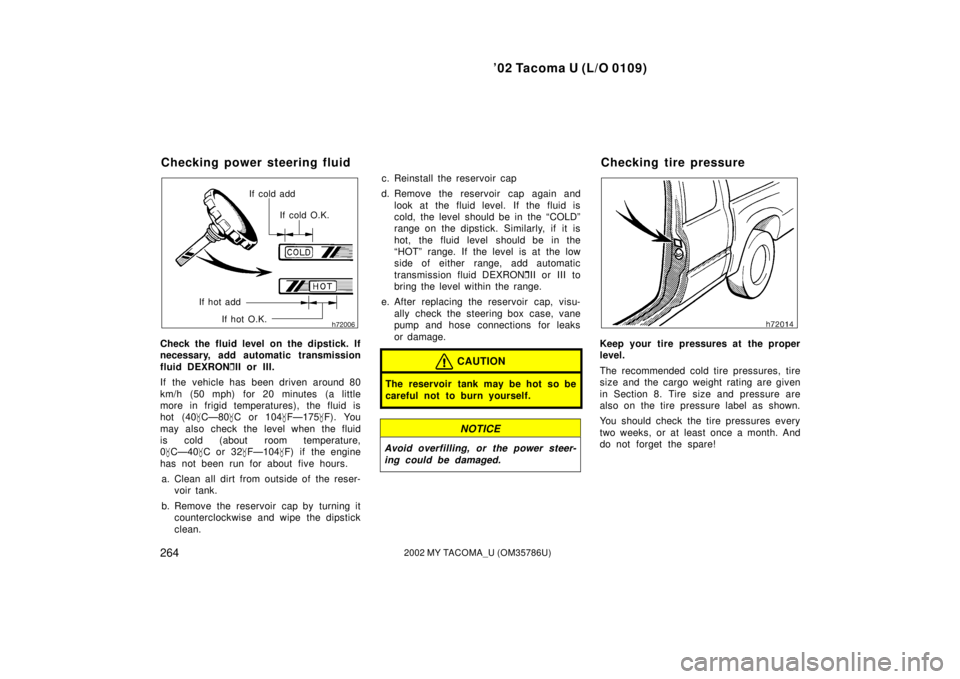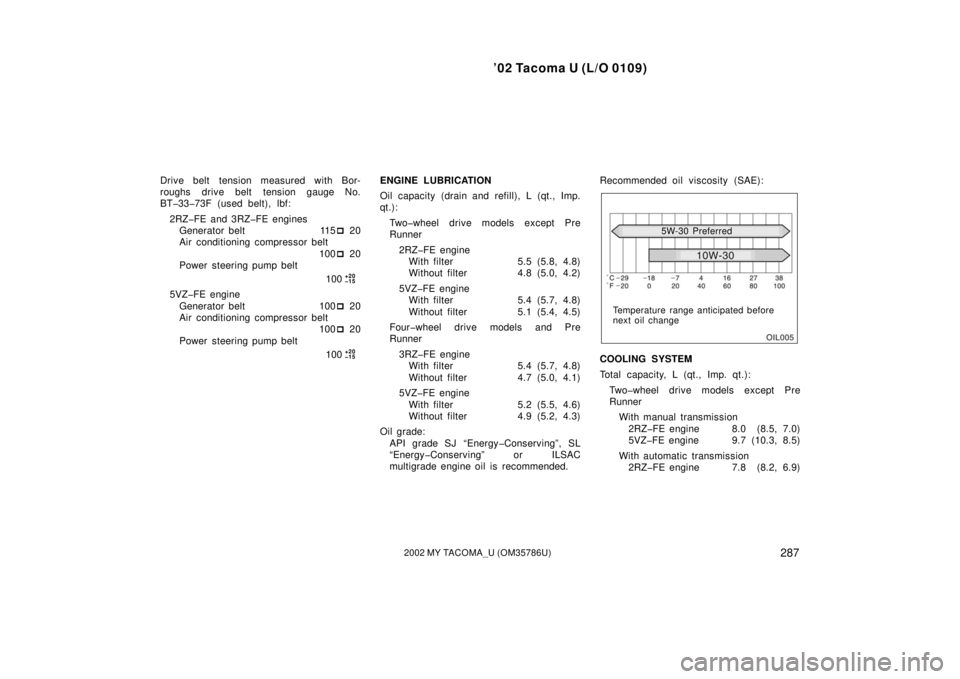Page 262 of 308

’02 Tacoma U (L/O 0109)
2562002 MY TACOMA_U (OM35786U)
�Be careful not to scratch the glass
surface with the wiper frame.
� When closing the engine hood,
check to see that you have not for-
gotten any tools, rags, etc.Here is a list of parts and tools you will
need on performing do�it�yourself mainte-
nance. Remember all Toyota parts are de-
signed in metric sizes, so your tools must
be metric.
CHECKING THE ENGINE OIL LEVEL
Parts (if level is low):
�Engine oil API grade SJ
“Energy�Conserving”, SL
“Energy�Conserving” or ILSAC
multigrade having viscosity proper for
your climate
Tools:
�Rag or paper towel
�Funnel (only for adding oil)
CHECKING THE ENGINE COOLANT
LEVEL
Parts (if level is low):
�“TOYOTA Long Life Coolant” or equiva-
lent
See Section 7�2 for details about cool-
ant type selection.
�Demineralized or distilled water
Tools:
�Funnel (only for adding coolant) CHECKING BRAKE FLUID
Parts (if level is low):
�SAE J1703 or FMVSS No.116 DOT 3
brake fluid
Tools:
�Rag or paper towel
�Funnel (only for adding fluid)
CHECKING POWER STEERING FLUID
Parts (if level is low):
�Automatic transmission fluid
DEXRON �II or III
Tools:
�Rag or paper towel
�Funnel (only for adding fluid)
CHECKING BATTERY CONDITION
Tools:
�Warm water
�Baking soda
�Grease
�Conventional wrench (for terminal
clamp bolts)
Parts and tools
Page 270 of 308

’02 Tacoma U (L/O 0109)
2642002 MY TACOMA_U (OM35786U)
If cold addIf cold O.K.
If hot add If hot O.K.
Check the fluid level on the dipstick. If
necessary, add automatic transmission
fluid DEXRON �II or III.
If the vehicle has been driven around 80
km/h (50 mph) for 20 minutes (a little
more in frigid temperatures), the fluid is
hot (40 �C—80 �C or 104 �F—175 �F). You
may also check the level when the fluid
is cold (about room temperature,
0 �C—40 �C or 32 �F—104 �F) if the engine
has not been run for about five hours.
a. Clean all dirt from outside of the reser- voir tank.
b. Remove the reservoir cap by turning it counterclockwise and wipe the dipstick
clean. c. Reinstall the reservoir cap
d. Remove the reservoir cap again and look at the fluid level. If the fluid is
cold, the level should be in the “COLD”
range on the dipstick. Similarly, if it is
hot, the fluid level should be in the
“HOT” range. If the level is at the low
side of either range, add automatic
transmission fluid DEXRON �II or III to
bring the level within the range.
e. After replacing the reservoir cap, visu- ally check the steering box case, vane
pump and hose connections for leaks
or damage.
CAUTION
The reservoir tank may be hot so be
careful not to burn yourself.
NOTICE
Avoid overfilling, or the power steer-
ing could be damaged.
Keep your tire pressures at the proper
level.
The recommended cold tire pressures, tire
size and the cargo weight rating are given
in Section 8. Tire size and pressure are
also on the tire pressure label as shown.
You should check the tire pressures every
two weeks, or at least once a month. And
do not forget the spare!
Checking power steering fluid Checking tire pressure
Page 288 of 308
’02 Tacoma U (L/O 0109)
2822002 MY TACOMA_U (OM35786U)
Dimensions
Regular cab models Xtra�cab models
Overall length
Overall height
∗ 8
Front tread
Rear tread Overall width
Wheelbase 4540 (178.7)
∗
1
4685 (184.4)∗25010 (197.2)∗1
5155 (203.0)∗2
1690 (66.5)
1765 (69.5)∗3, 41690 (66.5)
1625 (64.0)
∗4, 6
1615 (63.6)∗5, 6
1620 (63.8)∗4, 7
1630 (64.2)∗5, 7
3095 (121.9)
1450 (57.1)
1455 (57.3)
1455 (57.3) 1450 (57.1)
2625 (103.3) 1590 (62.5)
∗
3, 4
1605 (63.2)∗4
1615 (63.6)∗5
∗ 1
: Without rear step bumper∗2: With rear step bumper∗3: With 5VZ�FE engine∗4: With P235/55R16 tires∗5: With P205/75R15 tires∗6: With automatic transmission∗7: With manual transmission∗8: Unladen vehicle
TWO�WHEEL DRIVE MODELS EXCEPT PRE RUNNER mm (in.)
Page 290 of 308
’02 Tacoma U (L/O 0109)
2842002 MY TACOMA_U (OM35786U)
Without off�road packagekg (lb.)
Two�wheel drive models
2RZ�FE engine
Regular cabManual transmission680 (1500)
Automatic transmission671 (1480)
Xtra�cabManual transmission703 (1550)
Automatic transmission694 (1530)
5VZ�FE engineXtra�cabManual transmission623 (1375)
Four�wheel drive models
3RZ�FE engine
Regular cabManual transmission821 (1810)
Automatic transmission807 (1780)
Xtra�cabManual transmission739 (1630)
Automatic transmission725 (1600)
5VZ�FE engineXtra�cabManual transmission718 (1585)
Automatic transmission707 (1560)
Double cabAutomatic transmission632 (1395)
Pre Runner
3RZ�FE engine
Regular cabAutomatic transmission909 (2005)
Xtra�cabAutomatic transmission830 (1830)
Double cabAutomatic transmission757 (1670)
5VZ�FE engineXtra�cabAutomatic transmission791 (1745)
Double cabAutomatic transmission737 (1625)
Payload∗
Page 291 of 308
’02 Tacoma U (L/O 0109)
2852002 MY TACOMA_U (OM35786U)
With off�road packagekg (lb.)
Four�wheel drive models
3RZ�FE engineXtra�cabManual transmission716 (1580)
5VZ�FE engineXtra�cabManual transmission696 (1535)
Automatic transmission684 (1510)
Double cabAutomatic transmission603 (1330)
Pre Runner
3RZ�FE engineXtra�cabAutomatic transmission814 (1795)
Double cabAutomatic transmission734 (1620)
5VZ�FE engineXtra�cabAutomatic transmission768 (1695)
Double cabAutomatic transmission707 (1560)
∗: Occupants + luggage
Page 293 of 308

’02 Tacoma U (L/O 0109)
2872002 MY TACOMA_U (OM35786U)
Drive belt tension measured with Bor-
roughs drive belt tension gauge No.
BT�33�73F (used belt), lbf:2RZ�FE and 3RZ�FE enginesGenerator belt 115 � 20
Air conditioning compressor belt
100� 20
Power steering pump belt
100
+20
�15
5VZ�FE engineGenerator belt 100 � 20
Air conditioning compressor belt 100� 20
Power steering pump belt
100
+20
�15
ENGINE LUBRICATION
Oil capacity (drain and refill), L (qt., Imp.
qt.):
Two�wheel drive models except Pre
Runner2RZ�FE engineWith filter 5.5 (5.8, 4.8)
Without filter 4.8 (5.0, 4.2)
5VZ�FE engine With filter 5.4 (5.7, 4.8)
Without filter 5.1 (5.4, 4.5)
Four�wheel drive models and Pre
Runner
3RZ�FE engineWith filter 5.4 (5.7, 4.8)
Without filter 4.7 (5.0, 4.1)
5VZ�FE engine With filter 5.2 (5.5, 4.6)
Without filter 4.9 (5.2, 4.3)
Oil grade: API grade SJ “Energy�Conserving”, SL
“Energy�Conserving” or ILSAC
multigrade engine oil is recommended. Recommended oil viscosity (SAE):
5W-30 Preferred
Temperature range anticipated before
next oil change
COOLING SYSTEM
Total capacity, L (qt., Imp. qt.): Two�wheel drive models except Pre
RunnerWith manual transmission2RZ�FE engine 8.0 (8.5, 7.0)
5VZ�FE engine 9.7 (10.3, 8.5)
With automatic transmission 2RZ�FE engine 7.8 (8.2, 6.9)
Page 294 of 308

’02 Tacoma U (L/O 0109)
2882002 MY TACOMA_U (OM35786U)
Four�wheel drive models and Pre
RunnerWith manual transmission3RZ�FE engine 8.3 (8.8, 7.3)
5VZ�FE engine 10.1 (10.7, 8.9)
With automatic transmission 3RZ�FE engine 8.2 (8.7, 7.2)
5VZ�FE engine 10.0 (10.5, 8.8)
Coolant type: “TOYOTA Long Life Coolant” or equiva-
lent
With ethylene�glycol type coolant for a
proper corrosion protection of aluminum
components
Do not use alcohol type antifreeze or
plain water alone.
BATTERY
Open voltage
∗ at 20 °C (68 °F):
12.6—12.8 V Fully charged
12.2—12.4 V Half charged
11.8—12.0 V Discharged
∗: Voltage that is checked 20 minutes
after the key is removed with all the
lights turned off
Charging rates: 5 A max. CLUTCH
Pedal free play, mm (in.):
5—15 (0.2—0.6)
Fluid type: SAE J1703 or FMVSS No.116 DOT 3
MANUAL TRANSMISSION
Oil capacity, L (qt., Imp. qt.): 2RZ�FE engine 2.6 (2.7, 2.3)
3RZ�FE engine 2.5 (2.6, 2.2)
5VZ�FE engineTwo�wheel drive models 2.6 (2.7, 2.3)
Four�wheel drive models
2.2 (2.3, 1.9)
Oil type: Gear Oil API GL�4 or GL�5
Recommended oil viscosity: SAE 75W�90 AUTOMATIC TRANSMISSION
Fluid capacity (drain and ref
ill), L (qt.,
Imp. qt.):
Two�wheel drive models except Pre
RunnerUp to 2.4 (2.5, 2.1)
Four�wheel drive models and Pre Run-
ner Up to 2.0 (2.1, 1.8)
Fluid type: Automatic transmission fluid D�II or
DEXRON �III (DEXRON �II)
TRANSFER
Oil capacity, L (qt., Imp. qt.): 1.0 (1.1, 0.9)
Oil type: Gear Oil API GL�4 or GL�5
Recommended oil viscosity: SAE 75W�90
Page 295 of 308

’02 Tacoma U (L/O 0109)
2892002 MY TACOMA_U (OM35786U)
DIFFERENTIAL
Oil capacity, L (qt., Imp. qt.):Two�wheel drive models except Pre
Runner2RZ�FE engine 1.35 (1.4, 1.2)
5VZ�FE engine 2.55 (2.7, 2.2)
Four�wheel drive models and Pre
Runner
Front (except Pre Runner) 1.15 (1.2, 1.0)
Rear Short wheel baseWith rear differential lock system 2.65 (2.8, 2.3)
Without rear differential lock sys-
tem 2.55 (2.7, 2.2)
Extra long wheel base With rear differential lock system 2.95 (3.1, 2.6)
Without rear differential lock sys-
tem 2.45 (2.6, 2.2)
Oil type: Hypoid Gear Oil API GL�5 Recommended oil viscosity:
Front SAE 75W�90
Rear Above �18 �C (0 �F)
SAE 90
Below �18 �C (0 �F)
SAE 80W or 80W�90
CHASSIS LUBRICATION
Wheel bearings: Lithium base wheel bearing grease,
NLGI No.2
Front drive shaft thrust bushings: Synthetic oil and lithium soap base
chassis grease, NLGI No.1
Propeller shafts: SpidersLithium base chassis grease, NLGI
No.2
Slide yoke and double cardan joint Molybdenum�disulfide lithium base
chassis grease, NLGI No.2 BRAKES
Minimum pedal clearance when depressed
with a pressure of 490 N (50 kgf, 110 lbf)
when the engine is stopped and after de-
press the brake pedal several times, mm
(in.):
105 (4.1)
Pedal free play, mm (in.): 1—6 (0.04—0.24)
Pad wear limit, mm (in.): 1.0 (0.04)
Lining wear limit, mm (in.): 1.0 (0.04)
Parking brake adjustment when pulled with
the force of 196 N (20 kgf, 44 lbf): 12—18 clicks
Fluid type: SAE J1703 or FMVSS No.116 DOT 3
STEERING
Wheel free play: Less than 30 mm (1.2 in.)
Power steering fluid type: Automatic transmission fluid DEXRON �II
or III